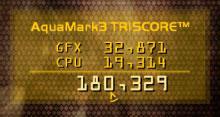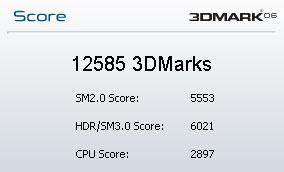INTEL MEROM BENCHMARK OVERLOCK REVIEW WORLD RECORD
![]()
|
|
 |
||||||||||||
| Posted:2006-05-15 By hardware review Number of View:7746 |
|||||||||||||
By :hardware review Posted:2006-05-15
intel merom benchmark overlock review world recordMerom kills 3DMark 2001 - Far beyond 60,000 points!
We're having some trouble finding words to describe Merom at the moment. During the last few days we've reported about new records being set, but we were still missing a few benchmarks. We suspected that Kyosen, which has done it again, had some more results coming, this time of a completely new caliber. That it would be this kind of blowout we had no idea, not even our wildest imagination could've come up with something like this. Using Dry ice Intel Merom T7400 was pushed a bit over 3400MHz and with two water cooled X1900 cards Kyosen managed to achieve a completely devastating result with 3DMark2001, 62398 points intel merom 3d 2001 benchmark
intel merom 3d 2005 benchmarkNot only this but he also set a new 3DMark05 world record, although with only a 5 points margin.
intel merom aquamark benchmarkA new record with Aquamark has also been achieved
intel merom 3d mark 2006 benchmarkWith 3DMark06 he accomlished a very respectful score of 12585, but still a few points short of a world record.
We are getting more and more curious of what Merom's bigger brother Conroe will bring to the desktop market during the third quarter.
those result look pretty impresive we also mentioned that Intel expects Merom to gain 20% more performance compared to Core Duo; Conroe promises performance increases of 40% over Pentium D 950 while decreasing power consumption by the same amount; and Woodcrest is forecasted to achieve an 80% jump in speed coupled with a 35% drop in power over today's dual-core Xeon DP 2.8 GHz. "Merom is the best processor we have ever built," summed up Pat Gelsinger, who runs Intel's digital enterprise group. Gelsinger added that Merom will be the most power-efficient processor on the market, and will give Intel a "very strong position" - strong enough, in fact, that Intel no longer feels the need to develop an integrated memory controller for Merom at this time. Once you wipe away some of the superlatives and hyperboles, the numbers produced by Intel have certainly impressed analysts and journalists here. But new questions have arisen: Why is Intel just now able to claim such performance and power jumps? What changed, besides the company's attitude, between last fall and today? According to the company, there are five key components that are responsible for the progress made with Merom:
More speed. Less power consumption. Intel promises a Formula 1 racecar than runs with the efficiency of a Mini Cooper. Is this realistic, or is there a catch? The simple answer: We don't know. And here is why. First, when we look at all the announcements thus far, it becomes clear that there is little besides promises to back up the company's fresh wave of claims. Intel demonstrated that its new platform is running on notebooks, desktops, and servers alike. But we have yet to believe the company when it states that ICM architecture will deliver what Intel promises. Second, all product demonstrations compared a future product against processors that are available today. Especially in the case of the Woodcrest / Opteron showdown, we know that AMD is unlikely to stand still, and certainly will continue to improve the performance of its processor line. Intel's aiming at a moving target; in fairness, so now is AMD. But once the targets finally line up with one another, their real differences in terms of performance and power consumption therefore may not be as dramatic as Intel portrayed here at IDF. Speculation will be the principal ingredient of discussions around Woodcrest, Conroe, and Merom (which will be introduced in exactly this order) until we actually can get our hands on a production-ready processor. Will it be faster and more power efficient than Athlon and Opteron when introduced? Perhaps. But here's a thought: Maybe this is the wrong question for us to be asking anyway. The real question is, what does that mean for you, the user? From the limited perspective we've been given this week, it certainly means that Intel Core Microarchitecture catapults Intel into a much more promising future than many had been envisioning. As a direct result, we are likely to see a higher level of innovation in micro processors and platforms, driven by a more competitive environment, at least in the near term. We continue to expect 2006 to become the most interesting year in the microprocessor industry thus far. If Intel is able to follow through with its promises made at IDF, we have no doubt that this year will reinvigorate enthusiasm for the microprocessor, as well as bring new opportunities for the industry behind it
we would be happy to answer for your question . if you have suggestion or comment
regarding this review our support would be glad to help just join our forum and ask u will get the best answer
to discuss check our forum section :-) RATE THIS REVIEW | |||||||||||||
![]()

intel merom benchmark overlock review world record
intel merom benchmark overlock review world record


7600gt review
7600gt is the middle card range.
We already benchmarked this video card and found that ...

 geforce 8800gtx and 8800gts
geforce 8800gtx and 8800gts  Xtreview software download Section
Xtreview software download Section  AMD TURION 64 X2 REVIEW
AMD TURION 64 X2 REVIEW  INTEL PENTIUM D 920 , INTEL PENTIUM D 930
INTEL PENTIUM D 920 , INTEL PENTIUM D 930  6800XT REVIEW
6800XT REVIEW  computer hardware REVIEW
computer hardware REVIEW  INTEL CONROE CORE DUO 2 REVIEW VS AMD AM2
INTEL CONROE CORE DUO 2 REVIEW VS AMD AM2  INTEL PENTIUM D 805 INTEL D805
INTEL PENTIUM D 805 INTEL D805  Free desktop wallpaper
Free desktop wallpaper  online fighting game
online fighting game  Xtreview price comparison center
Xtreview price comparison center 

- The new version of GPU-Z finally kills the belief in the miracle of Vega transformation
- The motherboard manufacturer confirms the characteristics of the processors Coffee Lake
- We are looking for copper coolers on NVIDIA Volta computing accelerators
- Unofficially about Intels plans to release 300-series chipset
- The Japanese representation of AMD offered monetary compensation to the first buyers of Ryzen Threadripper
- This year will not be released more than 45 million motherboards
- TSMC denies the presentation of charges from the antimonopoly authorities
- Radeon RX Vega 64 at frequencies 1802-1000 MHz updated the record GPUPI 1B
- AMD itself would like to believe that mobile processors Ryzen have already been released
- AMD Vega 20 will find application in accelerating computations
- Pre-orders for new iPhone start next week
- Radeon RX Vega 57, 58 and 59: the wonders of transformation
- ASML starts commercial delivery of EUV-scanners
- The older Skylake processors with a free multiplier are removed from production
- Meizu will release Android-smartphone based on Helio P40
- AMD Bristol Ridge processors are also available in American retail
- The fate of Toshiba Memory can be solved to the next environment
- duo GeForce GTX 1080 Ti in GPUPI 1B at frequencies of 2480-10320 MHz
- New Kentsfield overclocking record up to 5204 MHz
- Lenovo released Android-smartphone K8



computer news computer parts review Old Forum Downloads New Forum Login Join Articles terms Hardware blog Sitemap Get Freebies






